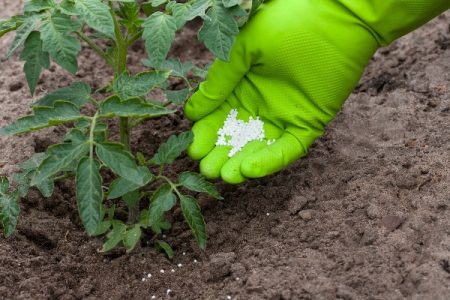
Growing tomatoes in a greenhouse will allow you to get a crop a month earlier than on open ground. To get strong and healthy tomatoes is almost impossible without fertilizing. To fertilize plants using organic and mineral substances. The normal development and fruiting of tomatoes depends on three main trace elements: nitrogen, phosphorus and potassium. What fertilizers and when to use them will be considered later in the article.
Content
Stages of fertilizing tomatoes in a greenhouse
The basic integrated fertilizing of tomatoes in a greenhouse involves the introduction of fertilizers in four stages. Saturation of plants with nutrients will allow you to grow tasty, large fruits. To fertilize plants, gardeners use both folk recipes and synthetic fertilizers.
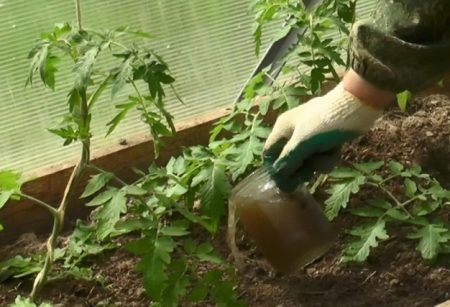
First feeding produced two weeks after planting seedlings in a greenhouse. During this period, the plant needs to be saturated with substances that will accelerate the growth of green mass, in order to form a strong skeleton in the future, which can withstand the load from the formed fruits.
At this stage, experienced gardeners use one of the following dressings:
- based on mullein (compost): in a bucket of water, dilute 0.5 kilograms of rotted manure, 30 grams of nitrophosphate.
- based on chicken manure: in a bucket of water, dilute 0.5 liters of liquid from chicken manure, which has been infused for a week, 30 grams of superphosphate and 15 grams of potassium sulphide.
- based on mineral fertilizers: in a bucket of water, dissolve 30 grams of nitrate and 30 grams of nitrophosphate.
- nettle based. Collect a nettle bucket, use gloves, as it is prickly and has poisonous stems and leaves. Grind the collected plants, place again in a bucket, fill with warm water, let it brew for two weeks. Do not be alarmed by the smell of infusion, feel free to water the plants. The consumption per bush is half a liter.
Second phase fertilizing occurs during the period of setting buds and flowering. During the formation of the ovary, the tomato requires the introduction of potassium and phosphorus. The solutions used to fertilize during setting buds and flowering:
- based on wood ash and boric acid: pre-boil 2 liters of water, add a kilogram of wood ash to boiling water, let the solution cool. Then add 10 grams of boric acid and 10 liters of water. Insist throughout the day. Water under the root, the consumption is 1 liter per bush.
- based on potassium sulphide and superphosphate. In 10 liters of water, dissolve 20 grams of potassium sulfide and 30 grams of superphosphate, mix thoroughly until the granules are completely dissolved. Every plant needs to be watered under the root.
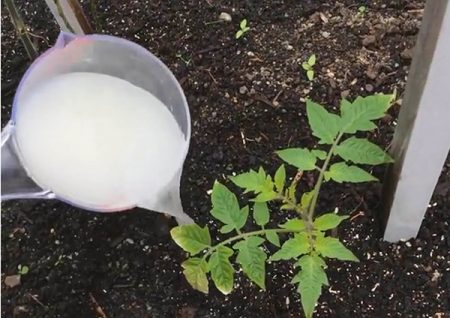
Third stage fertilizing occurs during the fruiting period. Saturation of tomatoes with nutrients is associated with an improvement in the taste of fruits. During fruiting, plants need to be fertilized with potassium-containing substances. Use one of the following liquid top dressings:
- based on humate and nitrophosphate. In a ten-liter bucket of warm water, dissolve 20 grams of nitrophosphate and 15 milliliters of humate, stir, water under the root. The consumption per tomato is 1 liter.
- based on yeast and sugar.Preparation of infusion and working solution for irrigation: in 3 liters of warm water, dissolve 120 grams of yeast and 150 grams of granulated sugar, mix the mixture until it is completely dissolved, leave to infuse for 7 days. The prepared infusion additionally needs to be diluted in water. For 10 liters of warm water you need 0.5 liters of infusion. Pour the resulting solution half a liter under the bush.
- based on magnesium sulfate and potassium nitrate. In a ten-liter bucket, dissolve 10 grams of nitrate, 25 grams of magnesium sulfate. Spend half a liter of the resulting solution on one bush.
How to grow “plump” tomatoes using top dressing?
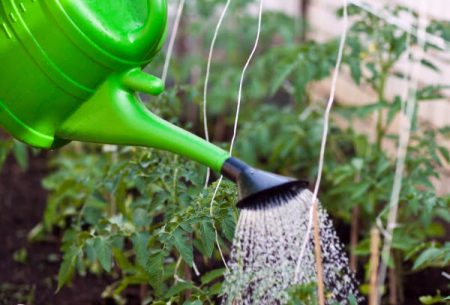
In the process of growing tomatoes, gardeners are faced with a problem such as stretching and thinness of the stem. Eliminate this deficiency will allow the introduction of balanced nutrients. During the formation of tomatoes, it is necessary to add calcium nitrate (10 grams are dissolved in 10 liters of water, watered 0.5 l. Under a bush), which contributes to the development of green mass.
Two weeks after planting seedlings, the tomato should be fed one of the following dressings:
- complex fertilizer "life-giving". Dry yeast - 15 grams, chicken droppings - half a kilogram, wood ash - half a kilogram, sugar - 150 grams should be dissolved in a bucket of warm water. Soak the solution for several days until the fermentation process stops. After that, the resulting mixture must be diluted in water in a ratio of 1 to 10.
- yeast fertilizer. Take three liters of warm water, dissolve in it a half glass of sugar and 100 grams of yeast (fresh in a pack). Stir all the ingredients, leave to insist for a day (if possible, stir occasionally).
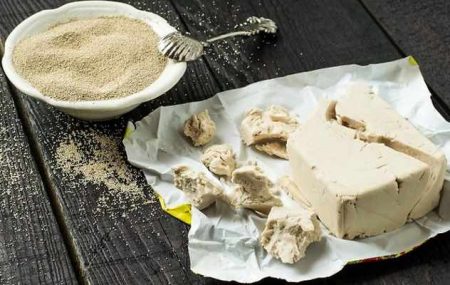
Root and foliar top dressing
Fertilizing is divided into root and foliar. The above top dressings are included in the group of root applications of nutrients. Let us focus on foliar fertilizers that were not mentioned above. The use of foliar top dressing is aimed at increasing productivity by spraying the green mass of the plant with various solutions. For processing plants, use the following recipes:
- urea-based solution. Dissolve 20 grams of urea in a bucket of water, pour into a sprayer, process the tomatoes. The resulting solution is sufficient for processing one hundredth of a vegetable crop. Spray before the ovary appears.
- boric acid based solution. Dissolve 1 gram of acid in one liter of water, stir, pour into a spray bottle, completely spray the entire plant. Processing can be carried out three times, the first, during budding, the second, during flowering, and the third during the ripening period of vegetables.
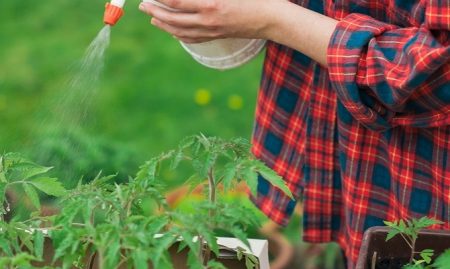
- solution based on the Epin phytohormone. The working solution is prepared on the basis of one liter of water and six drops of the drug. The resulting mixture is enough to spray 30 square meters of plantings.
- a solution based on iodine and milk is included in the group of folk recipes for foliar top dressing. To prepare the solution, take 3 liters of milk, dissolve 15 drops of medical iodine, then shake the mixture, season with a spray bottle and spray the plants. Treat green mass in the evening or in the morning for two days.
In August, the last fruit formation of this season is completed, therefore it is necessary to produce last feeding. First you need to pinch the top of the tomatoes, and then feed them with liquid fertilizer based on monophosphate and calimagnesia. Take 10 liters of water, place 10 grams of Kalimagnesia, 15 grams of monophosphate, mix until completely dissolved. Water each bush half a liter.
Reviews of gardeners
Gardeners from various parts of Russia equally use both folk recipes for fertilizing and apply synthetic fertilizers.Agronomists note that to achieve high productivity from tomatoes, it is possible only in the case of complex feeding. Gardeners speak well of fertilizers based on compost and superphosphate, as well as spraying with a solution based on the growth stimulator Epin.




 Low-growing tomatoes, without pinching: 5 of the most delicious varieties
Low-growing tomatoes, without pinching: 5 of the most delicious varieties Why tomato seedlings grow poorly
Why tomato seedlings grow poorly We grow a tomato in a shell
We grow a tomato in a shell Growing tomatoes without watering according to the method of Kazarin
Growing tomatoes without watering according to the method of Kazarin